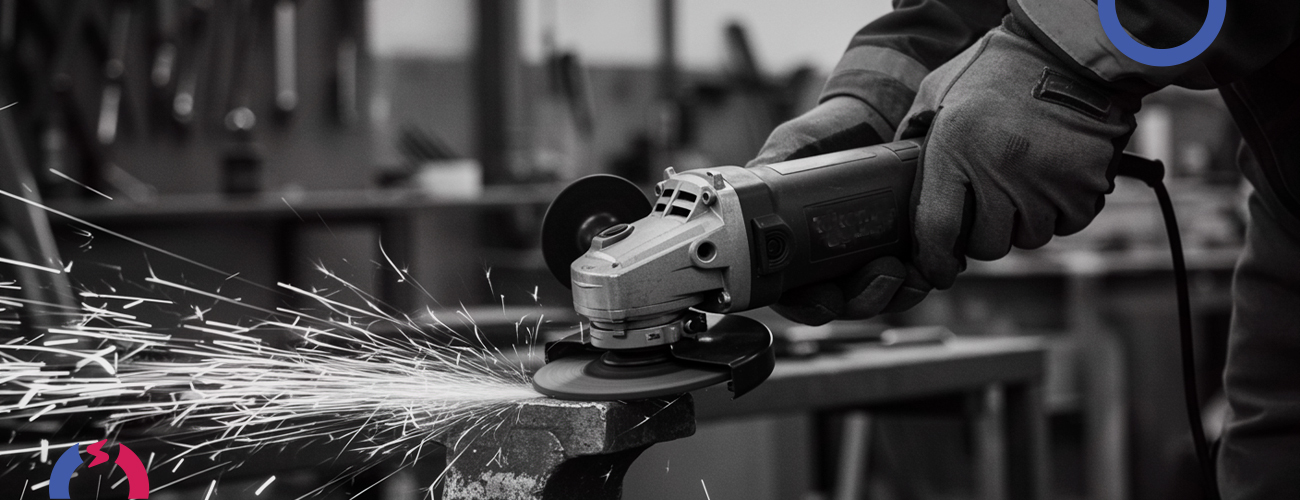Angle grinders are one of the most versatile and indispensable tools in both professional and DIY workshops. Known for their power, precision, and ability to handle a wide variety of tasks, angle grinders are a must-have tool for anyone involved in metalworking, construction, or renovation. Whether you’re cutting, grinding, or polishing, an angle grinder offers unmatched flexibility to tackle a range of tasks.
What Are Angle Grinders?
An angle grinder, also known as a side grinder, is a handheld power tool used for grinding, cutting, polishing, and sanding various materials, including metal, concrete, and stone. It consists of a rotating abrasive disc that is driven by an electric motor or a pneumatic mechanism. The disc spins at high speeds, allowing the grinder to perform different functions depending on the type of attachment used.
Types of Angle Grinders:
-
Corded Angle Grinders: These grinders are powered by electricity and are usually more powerful than their cordless counterparts. They are ideal for heavy-duty work in industrial settings.
-
Cordless Angle Grinders: Powered by rechargeable batteries, these grinders offer more flexibility and portability. They are perfect for light to medium-duty tasks and can be used in areas without access to electricity.
-
Pneumatic Angle Grinders: These grinders are powered by compressed air and are commonly used in workshops that have access to an air compressor. They offer continuous power and are ideal for tasks that require long periods of use.
Uses of Angle Grinders:
-
Cutting: Angle grinders can easily cut through metal, concrete, and even stone. By attaching a diamond blade or a cutting disc, you can make precise cuts in various materials.
-
Grinding: When fitted with a grinding disc, an angle grinder is perfect for smoothing rough surfaces, removing rust, or sharpening tools and blades.
-
Polishing and Sanding: With the right attachments, angle grinders can be used for polishing metal surfaces, sanding wood, or smoothing down concrete. This makes them a versatile tool for finishing tasks.
-
Deburring: After cutting or grinding, angle grinders are excellent for deburring, which involves removing sharp edges from metal or other materials to create a smoother finish.
-
Surface Preparation: Angle grinders are widely used in surface preparation tasks, such as removing paint, rust, or adhesive from walls, floors, and machinery.
Advantages of Angle Grinders:
-
Versatility: Angle grinders are incredibly versatile tools that can perform a wide range of tasks with different attachments. They can handle everything from cutting and grinding to polishing and sanding.
-
Power and Speed: Angle grinders are capable of delivering high speeds and torque, making them ideal for demanding tasks and materials that require significant force to work with.
-
Portability: Angle grinders are relatively lightweight and portable, making them easy to carry around and use in tight or hard-to-reach spaces.
-
Cost-Effective: Angle grinders offer a great return on investment due to their wide range of uses. Rather than purchasing multiple tools for different tasks, an angle grinder can handle several functions, reducing the overall cost of tools in a workshop.
How to Choose the Right Angle Grinder:
-
Power Rating: The power rating of an angle grinder, usually measured in watts (W) or horsepower (HP), determines the grinder’s ability to handle heavy-duty tasks. For professional or industrial use, a more powerful grinder will be necessary.
-
Disc Size: Angle grinders come in different sizes, with the most common being 4.5 inches, 5 inches, and 7 inches. The size of the disc determines the depth of the cut and the type of material you can work with.
-
Ergonomics: Look for grinders with ergonomic handles that reduce vibration and improve comfort during extended use. This will help reduce fatigue and increase accuracy.
-
Safety Features: Ensure the grinder has essential safety features such as a safety guard, a trigger lock, and an anti-restart function to prevent accidental starts.
Maintenance Tips for Angle Grinders:
To ensure your angle grinder performs optimally and lasts for years, regular maintenance is essential:
-
Check for Wear: Regularly inspect the disc for wear and replace it when necessary. Worn discs can compromise the quality of the cut or grind.
-
Clean the Grinder: After each use, clean the grinder to remove dust and debris. This will help prevent build-up, which can cause the tool to overheat.
-
Lubricate Moving Parts: Lubricate the grinder’s bearings and other moving parts periodically to keep the tool running smoothly.
-
Inspect the Electrical Cord: If you’re using a corded angle grinder, regularly inspect the power cord for any signs of damage or fraying to avoid electrical hazards.
Conclusion:
Angle grinders are essential tools in any workshop, offering a high level of versatility, power, and efficiency. From cutting and grinding to polishing and sanding, they can handle a wide variety of tasks, making them indispensable for professionals and DIY enthusiasts alike. With proper maintenance and the right attachments, an angle grinder can serve you for years, helping you complete projects with ease and precision.


